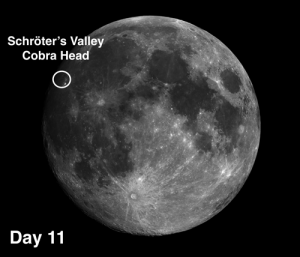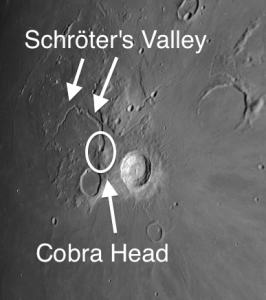 The week of July 23-29 takes us from Day 11 to Day 16. Full Moon is on Friday. This week we will highlight Rima Marius, visible on Tuesday night at 11:00 PM EDT, also Schröter’s Valley and the Cobra Head volcano viewable on Tuesday night.
The week of July 23-29 takes us from Day 11 to Day 16. Full Moon is on Friday. This week we will highlight Rima Marius, visible on Tuesday night at 11:00 PM EDT, also Schröter’s Valley and the Cobra Head volcano viewable on Tuesday night.
Rima Marius: [NW/H4-5] Just to the northwest of the crater Marius C is Rima Marius, a sinuous rille that extends for 150 miles. When the rille starts out, it is about 1.2 miles wide (~1 arc-second), but it tapers down to only 0.3 miles. Because a line can be easily distinguished when a point of the same diameter is totally invisible, you should be able to see the rille when its width is well below the theoretical limits of your telescope. See how far you can extend Rima Marius across the lunar surface.
 Schröter’s Valley/Cobra Head: [NW/G5-4] Schröter’s Valley is the Moon’s most impressive sinuous rille and was created when a monstrous lava tube collapsed. It begins at a volcano that is popularly known as “the Cobra Head” and then meanders for 100 miles toward Oceanus Procellarum. For most of its length it varies between three and six miles wide and is up to 3,000 feet deep. It is estimated that at the peak of its activity an incredible 10 million tons of lava per second flowed through Schröter’s Valley! At the end of its 100-mile journey the lava dramatically cascaded over a 3000-foot-high cliff into Oceanus Procellarum, which it then filled to a depth of 600 feet!
Schröter’s Valley/Cobra Head: [NW/G5-4] Schröter’s Valley is the Moon’s most impressive sinuous rille and was created when a monstrous lava tube collapsed. It begins at a volcano that is popularly known as “the Cobra Head” and then meanders for 100 miles toward Oceanus Procellarum. For most of its length it varies between three and six miles wide and is up to 3,000 feet deep. It is estimated that at the peak of its activity an incredible 10 million tons of lava per second flowed through Schröter’s Valley! At the end of its 100-mile journey the lava dramatically cascaded over a 3000-foot-high cliff into Oceanus Procellarum, which it then filled to a depth of 600 feet!
OF ADDITIONAL INTEREST ON THE MOON THE WEEK OF JULY 23:
Well there’s good news and bad news: The longest lunar eclipse of the century will occur on July 27, and it will be visible from almost the entire world, except the United States!
On July 18, the International Astronomical Union announced the discovery of 12 new moons orbiting Jupiter. This brings the total number of Jupiter’s satellites to a whopping 79!
Early Wednesday morning, July 25th, at 2:20 A.M. EDT, you will be able to see Saturn and the Moon in the same field of view of a low power eyepiece. Saturn will be just 1° 13′ south of the Moon (which will be pretty bright at Day 12.4). Or for a more reasonable time, try 11:00 P.M. EDT on Tuesday night when it will be 1° 42′ away, but that will move it out of the same field of view with the Moon.
======================
It is highly recommended that you get a copy of Sky and Telescope’s Field Map of the Moon, the very finest Moon map available for use at the telescope. It is available for $10.95 at www.skyandtelescope.com and on Amazon. All features mentioned in this blog will be keyed to the grid on the Field Map and will look like this: Plato: [NW/D9]
Credits:
Courtesy of Gray Photography of Corpus Christi, Texas
Lunar photos: NASA / USGS / BMDO / LROC / ASU / DLR / LOLA / Moon Globe. Used by permission
- Rupes Cauchy: A Best Known Fault on the Moon - July 22, 2024
- Moon Crater Schickard – Crater Floor has Stripes - July 15, 2024
- Moon Craters Langrenus and Vandelinus - July 8, 2024